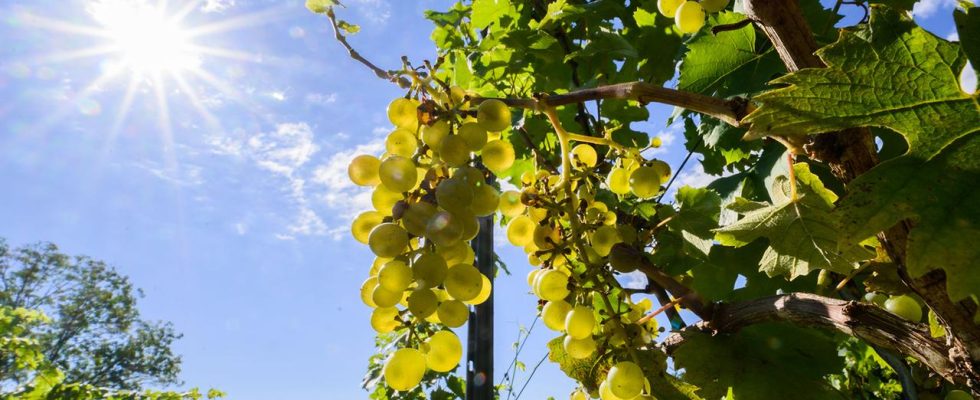Drought, heat and heavy rain are causing problems for viticulture in Germany. The first wineries are trying to use unknown historical grape varieties that have advantages under changing climatic conditions.
Many do not even know what grows there at the foot of a steep slope near Cochem on the Moselle: Gelber Kleinberger is a historic grape variety that used to be native to the Moselle, but then disappeared for a long time. The vines are still small. The Reitz family winery only planted them three years ago and parted with Riesling vines for this – for the small winery “a piece of lived wine-growing history” and a way of countering climate change.
Contribution to more biodiversity
Gernot Kallweit is responsible for marketing and product innovation in the winery. In times of heat, drought and heavy rain, the historical variety has advantages, he explains. “Yellow Kleinberger, unlike Riesling, is thick-skinned, which means the grapes don’t get sunburnt as easily.” Another plus point is a comparatively large distance between the individual grapes, according to Kallweit. “This way the grapes are better aerated after heavy rain. If they were closer together, it could lead to rot more easily.“
The decision to part with Riesling vines and to rely on the historic variety took courage from the small winery from the Mosel. Because newly planted vines do not bring any yield in the first few years. However, the family winery also sees a contribution to climate protection. By planting the historical varieties, it contributes to biodiversity in viticulture.
Gernot Kallweit draws a comparison to forests and meadows: “The more species-rich an environment, the more stable it is against climatic influences and pests.” There is also a variety of tastes. The expert raves about the aromas of historical grape varieties, which are very different from those of the well-known varieties.
Grapes with thick skins don’t burst as easily
A few weeks ago, the Reitz winery planted a second historic grape variety. “We are the only winery in Germany that grows black-blue Riesling,” says Kallweit. This is a Pinot red wine that was cultivated on the Moselle, among other places, for many centuries before it disappeared. With regard to climate influences, he has similar advantages as Gelber Kleinberger.
“Because the grapes are thick-skinned, they don’t burst open as quickly in heavy rain. And the thick skin also protects against the spotted-wing drosophila, which bores through the skin of the grapes and lays its eggs there,” says Kallweit. The fact that black-blue Riesling ripens much later than, for example, Pinot Noir is also useful because of climate change. Because grapes that are not yet ripe are less susceptible to rot after heavy rain.
Historical varieties not “silver bullets”
Currently, the proportion of historical varieties nationwide is negligible. For the ARDenvironmental expert Werner Eckert, they could therefore at most be part of a solution package: “They have one or the other property that is useful in climate change. However, there are also a number of the well-known and widespread varieties that have exactly the same properties or that could be optimized for such properties.”
In addition, these historical varieties are “no silver bullets,” emphasizes Eckert. “As a rule, they didn’t disappear because they couldn’t cope with the climate of the recent past, but because their earnings were weak or uncertain, or because they simply no longer corresponded to the taste preferences of consumers.”
In addition, resistance to fungal diseases tends to become more important in climate change. And that’s where the historical varieties are no better than the classic ones, says the expert. “Only new breeds that have been crossed with wild vines bring improvements.”
Experts advocate new breeds
Reinhard Töpfer, head of the Julius Kühn Institute for Vine Breeding at the Federal Research Institute for Cultivated Plants, argues similarly. There, both old, historical grape varieties and new varieties are examined.
Historical varieties, like all common varieties, are susceptible to introduced plant diseases, explains Töpfer. “I would clearly focus on new breeds, as they provide answers to climate change and at the same time are fungus-resistant and can also cope with fewer pesticides.” Some of these cultivars also show very good characteristics under drought stress or heat, and many new cultivars are thick-skinned.
For Gernot Kallweit, however, historical grape varieties are a better alternative to new varieties: “We’re talking about several thousand years of wine history, so unlike new varieties, they have definitely been climate-tested over a long period of time.” In the coming year, the Reitz winery is planning to plant a third historical wine variety: the Weißer Traminer. This was also widespread on the Moselle up to 150 years ago.

